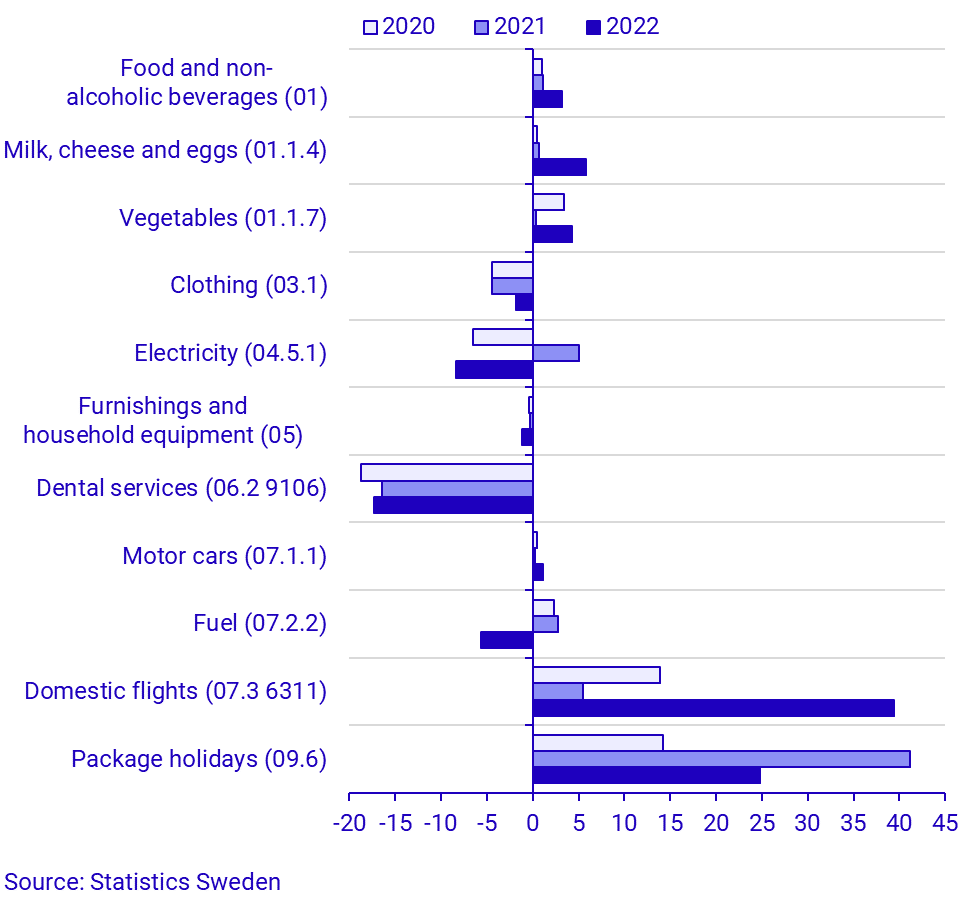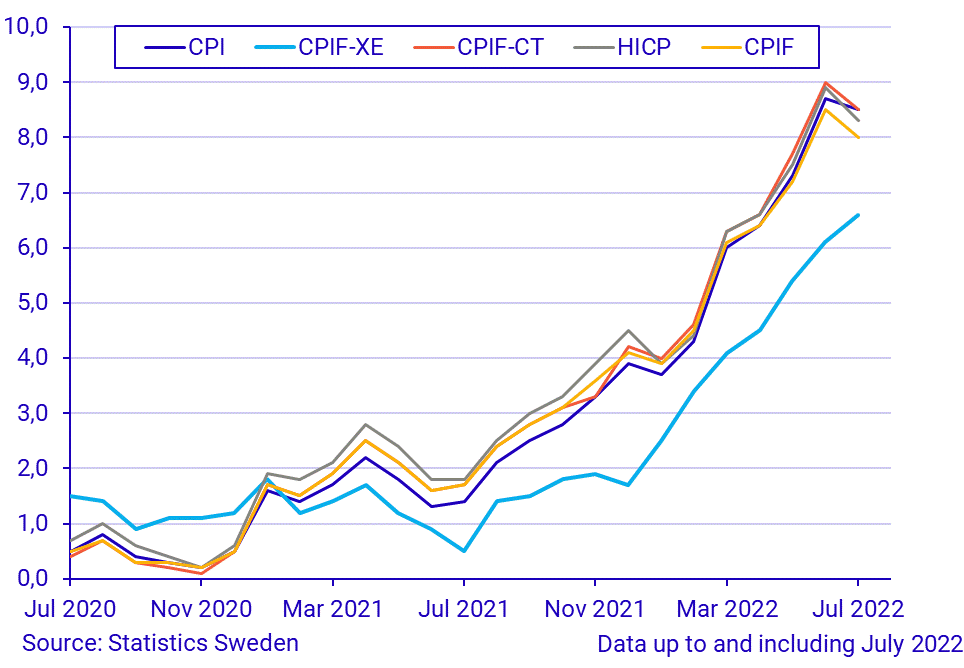Consumer Price Index (CPI), July 2022
Inflation rate was 8.0 percent in July 2022
Statistical news from Statistics Sweden 2022-08-12 8.00
The CPIF (Consumer Price Index with fixed interest rate) 12-month inflation rate was 8.0 percent in July 2022. This marks a decrease from June when the inflation rate was 8.5 percent. On a monthly basis, the inflation rate according to the CPIF fell by 0.2 percent
“Prices on electricity and fuels fell in July, which contributed to the CPIF’s first observed decrease since January”, says Carl Mårtensson, statistician at Statistics Sweden.
In brief
| Index Numbers |
Monthly changes, percent |
Annual changes, percent |
|
|---|---|---|---|
| CPI (1980=100) | 371.28 | 0.1 | 8.5 |
| CPIF (1987=100) | 242.25 | ‑0.2 | 8.0 |
| CPIF-XE (1987=100) | 224.68 | 0.4 | 6.6 |
- Food prices continued to increase, primarily prices for vegetables, milk, cheese and eggs.
- Lower electricity and fuel prices contributed to a declining inflation rate in July.
- The inflation rate according to CPIF excluding energy increased from 6.1 percent in June to 6.6 percent in July.
Lower energy prices
The CPIF fell by 0.2 percent from June to July. In the corresponding period a year ago, the CPIF rose by 0.3 percent.
The monthly rate of change was affected by lower fuel prices. The decrease in the monthly rate of change was offset by higher prices on food, primarily vegetables, milk, cheese and eggs.
The prices on fuels fell in July while the prices for purchasing a car increased. There was a price increase for domestic flights and package holidays for charter had a large contribution to the CPIF in July, which is seasonally normal.
The price for dental care fell in July as well as prices for furnishings- and household equipment. There was a price decrease for clothing in July due to summer sales, which is seasonally normal.
The table below shows changes on a monthly basis and contributions to the CPIF based on the goods and services that had the greatest impact on the CPIF in July 2022. The results are presented by COICOP category. COICOP refers to the United Nations classification of household consumption expenditure.
| Category (Coicop) | Monthly changes, percent |
Contribution to CPIF Monthly change, percentage points |
|---|---|---|
| Food and non-alcoholic beverages (01) | 3.2 | 0.5 |
| Milk, cheese and eggs (01.1.4) | 5.8 | 0.1 |
| Vegetables (01.1.7) | 4.3 | 0.1 |
| Clothing (03.1) | ‑1.9 | ‑0.1 |
| Electricity (04.5.1) | ‑8.3 | ‑0.4 |
| Furnishings and household equipment (05) | ‑1.2 | ‑0.1 |
| Dental sevices (06.2 9106) | ‑17.3 | ‑0.2 |
| Motor cars (07.1.1) | 1.1 | 0.1 |
| Fuel (07.2.2) | ‑5.6 | ‑0.2 |
| Domestic flights (07.3 6311) | 39.4 | 0.1 |
| Package holidays (09.6) | 24.8 | 0.1 |

Seasonal patterns and temporary price changes
Price changes on goods and services may be seasonal or temporary. The figure above shows the monthly changes this year and in the two preceding years for those goods and services which had the largest impact on the CPIF monthly change.
In July 2022 food prices increased, which aligns with normal seasonal patterns. Dairy products and vegetables do usually exhibit an increase in prices during the month of July, yet the current year’s increases are larger than what is usual. Prices of domestic flights and package holidays saw increases that were normal in respect to seasonal patterns.
Electricity prices have been both increasing and decreasing the last three years and it decreased in July. The fuel prices decreased in July 2022, compared to the last two years when it increased in July.
Furthermore, prices of dental care and clothing decreased, which is in line with normal seasonal patterns for July.
Decreased inflation rate in July
The inflation rate according to the CPIF, that is, the change in the CPIF over the past 12-month period, was 8.0 percent in July 2022. This marks a decrease from June when the inflation rate was 8.5 percent.
The inflation rate was mainly affected by price increases on food and non-alcoholic beverages. The largest contributions are attributable to price increases in housing costs where the price of electricity had a prominent role. Prices also increased for goods and services related to transport, where the current year’s relatively higher cost of fuels was the greatest factor together with higher car prices.
Moreover, price increases in clothing and shoes, restaurants and hotels, recreational and cultural services as well as miscellaneous goods and services have made an impact on the inflation during the last 12 months.
The inflation rate according to the CPIF excluding energy was 6.6 percent in July, up from 6.1 percent in June.
| Category (Coicop) | Yearly change, percent |
Contribution yearly change CPIF percentage points |
|---|---|---|
| Food and non-alcoholic beverages (01) | 13.5 | 1.9 |
| Clothing and footwear (03) | 5.2 | 0.2 |
| Housing (04) | 7.1 | 1.7 |
| Electricity (04.5.1) | 22.0 | 0.7 |
| Furnishings and household equipment (05) | 11.1 | 0.8 |
| Transport (07) | 12.4 | 1.8 |
| Motor cars (07.1.1) | 9.4 | 0.5 |
| Fuel (07.2.2) | 41.3 | 1.1 |
| Recreation and culture (09) | 3.8 | 0.5 |
| Restaurants and hotels (11) | 8.9 | 0.5 |
| Miscellaneous goods and services (12) | 5.6 | 0.4 |
Other measures of inflation
Statistics Sweden calculates different inflation measures for different purposes. The CPIF is the Riksbank’s target variable, while the CPI is the measure used for purposes of compensation.

Definitions and explanations
The CPIF shows the same price trend as the CPI, but without the direct effects of a changed monetary policy. The CPIF is the Riksbank’s target variable for the inflation target.
The CPIF excluding energy (CPIF-XE) and the CPIF with constant tax (CPIF-CT) are two other measures of inflation produced by Statistics Sweden on behalf of the Riksbank. In the CPIF-XE, energy products are excluded from the CPIF, while in the CPIF-CT the taxes and subsidies associated with the products in the CPIF are kept constant.
The HICP (Harmonised Index of Consumer Prices) is produced by all EU Member States. This measure has a somewhat smaller coverage than the CPI and the CPIF, mainly because parts of households’ housing costs are omitted.
Next publishing will be
2022-09-14 at 8:00.
Statistical Database
More information is available in the Statistical Database
Feel free to use the facts from this statistical news but remember to state Source: Statistics Sweden.
